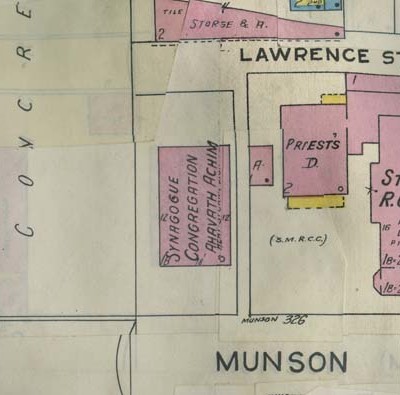
The area at the junction of the Ohio River and Chartiers Creek was settled in the mid-18th century, and the McKees Rocks borough was incorporated in 1892. Along with neighboring Stowe Township, the area later became known colloquially as Sto-Rox.
The area was mostly undeveloped countryside when Beth Hamedrash Hagadol in Pittsburgh purchased land in the area for its cemetery as early as 1876. Beth Jacob Congregation started a neighboring cemetery sometime between 1880 and 1900. As a town emerged, McKees Rocks attracted Jewish hucksters and peddlers from the Hill District of Pittsburgh. Some settled permanently and started businesses, taking advantage of the proximity to city wholesalers. They lived mostly in a low-lying part of the town known as “The Bottoms.”
A group of Jewish merchants chartered Ahavas Achim Congregation in 1903. Sometime after, they built a synagogue on Munson Avenue. The synagogue occupied a lot alongside the southern approach to the McKees Rocks Bridge, although the synagogue was likely already in place before the bridge was built in 1931. No records of the congregation have survived, but given the location of the synagogue it was likely impacted by the St. Patrick’s Day Flood in 1936, which caused extensive damage throughout the Bottoms.
Before World War II, Avahas Achim had a full-time rabbi and the Jewish community supported a full-time shochet (kosher butcher). McKees Rocks also had two religious schools operating under the auspices of the Southwestern District of Pennsylvania Jewish Religious School program. It is unclear whether the schools operated simultaneously.
Aside from its early years, the Jewish community of McKees Rocks grew most rapidly in the decade before World War II. The American Jewish Yearbook listed a population of 220 in its 1918-1919 edition, 240 in its 1927-1928 edition and 330 in its 1940-1941 edition. During the Great Depression and World War II, many Jewish families in McKees Rocks moved to Squirrel Hill and the East End in Pittsburgh. The Jewish population of the borough fell to 260 by the 1950-1951 edition of the American Jewish Yearbook.
Ahavas Achim dissolved at some point after 1950 and the synagogue was demolished no later than 1992. The Beth Hamedrash Hagadol-Beth Jacob Memorial Park remains active.